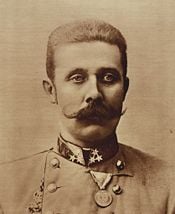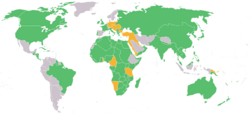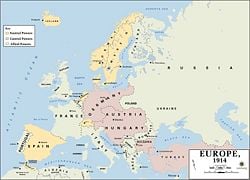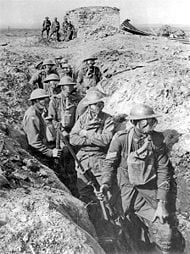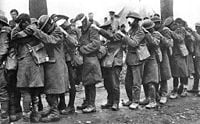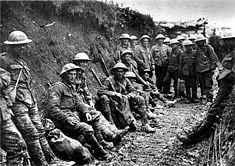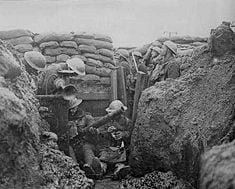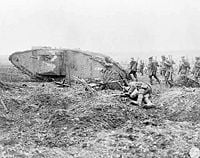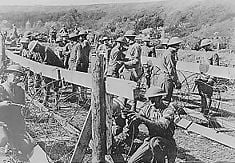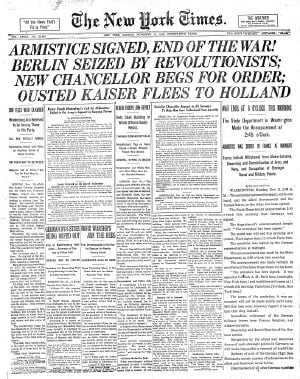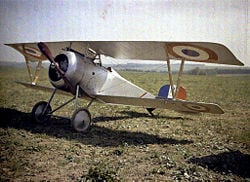World War I
| World War I | |||||||
|---|---|---|---|---|---|---|---|
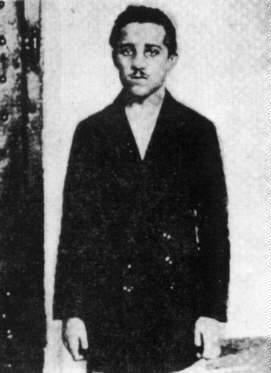 Gavrilo Principâthe igniting torch of World War I | |||||||
| |||||||
| Combatants | |||||||
| Allies: Serbia, Russia, France, Romania, Belgium, British Empire, United States, Italy, and others |
Central Powers: Germany, Austria-Hungary, Bulgaria, Ottoman Empire | ||||||
| Casualties | |||||||
| Military dead: 5 million Civilian dead: 3 million Total dead: 8 million |
Military dead: 4 million Civilian dead: 3 million Total dead: 7 million | ||||||
The First World War, known as the Great War before 1939 and as World War One after 1950, lasted from August 1914 to the final Armistice with Germany on November 11, 1918. During the war, it was referred to as the war to end all wars. Some question the appropriateness of the term âworld warâ because it was largely a European, North African, and Middle Eastern war. However, Canada, Australia, New Zealand, South Africa, India, and other British dominions and colonies contributed troops, and the United States also entered the conflict. Much of Asia and South America were not directly involved. The Allies of World War I, led by the United Kingdom, France, Russia (until 1917), and the United States (after 1917), defeated the Central Powers, led by the German Empire, the Austro-Hungarian Empire, and the Ottoman Empire. The war caused the disintegration of four empires: Austro-Hungarian, German, Ottoman, and Russian. It also brought about radical change in the European and Middle Eastern maps. The Allied Powers before 1917 are sometimes referred to as the Triple Entente and the Central Powers are sometimes referred to as the Triple Alliance. Many people believed that this would be the last European conflict and that in the future, diplomacy and detente would resolve differences. Many question whether the war was necessary, suggesting that it could have been avoided.
The legacy of the war, in many respects, was World War II, which was rooted in the punitive sanctions that the World War I's victors placed on Germany. The war can be represented as totalitarian regimes verses democratic regimes, but that is a somewhat simplistic analysis because rivalry and jealousy between the two sides was a fundamental issue. Germany felt that it was entitled to an empire; Britain, France, and even Belgium possessed extensive overseas territory while Germany had just a few colonies. The democratization process, though, was more advanced among the Allies than in Germany and her main ally, the Ottoman Empire. Humanity should learn from the legacy of this war that war cannot end warâit can only lead to more violence. The higher principle of peaceful resolution of differences attracted much interest after 1918 when the League of Nations was formed, but the nations of the world were unwilling to establish this as an effective body, being reluctant to give it any real power. President Woodrow Wilson had been one of its chief architects but the U.S.A. did not join and league members tended to act in their own interest, rather than in that of all members.
Causes
Bosnia and Herzegovina On June 28, 1914, Archduke Franz Ferdinand, heir to the Austrian throne, was assassinated in Sarajevo by Gavrilo Princip of Young Bosnia, a group whose aims included the unification of the South Slavs and independence from Austria. This assassination set in motion a series of fast-moving events that escalated into a full-scale war. The cause of the conflict, however, is complex. Historians and political scientists have grappled with this question for nearly a century without reaching a consensus. The treaty that ended the war required Germany to admit to being the aggressor (Article 231) but this was achieved in the context of Germany's defeat, economic sanctions, and the threat of renewed hostilities. The damage this caused to national pride would help Adolf Hitler's rise to power.
Alliances
Political scientists regard the building of alliances as a cause, specifically the formation of the Triple Entente and Triple Alliance. Alliances emboldened participating nations, leading each to believe that they had powerful backing. Both camps functioned in unique ways that contributed to the spread of war. For the Triple Alliance, the strong relationship between Germany and Austria expanded the conflict to a level where it would include at least four participants. Russia, France, and Britain had a relationship that was much less certain in 1914, contributing to the fact that each made the decision to go to war without collaborative consultation and with their own interests in mind.
Arms races
The German-British naval arms race drastically intensified after the 1906 launch of the HMS Dreadnought, a revolutionary battleship that made all previous battleships obsolete. A major naval arms race in shipbuilding developed, related to the concept of new imperialism, furthering the interest in alliances. Kennedy argues that both nations adopted U.S. Rear Admiral Alfred Thayer Mahan's conclusion that control of the oceans was vital to a great nation. (Kennedy, 1997) Additionally, this concentration kept related industries active and unemployment down while minimizing internal strife through the focus on a common, patriotic goal. Different scholars have different opinions about the degree to which the arms race was itself a cause of the war. Ferguson points out that Britain easily maintained her advantage. On the other hand, both sides were prepared for war. (Ferguson, 1999)
Plans, distrust, and mobilization: The First out of the Gate theory
Many political scientists argue that the German, French, and Russian war plans automatically escalated the conflict. Fritz Fischer (1908-1999) and his followers emphasized the inherently aggressive nature of Germany's Schlieffen Plan, which outlined German strategy if at war with both France and Russia. Conflict on two fronts meant that Germany had to eliminate one opponent quickly before attacking the other, relying on a strict timetable. France's well defended border with Germany meant that an attack through Belgian (and possibly Dutch) territory was necessary, creating a number of unexpected problems. In a greater context, France's own Plan XVII called for an offensive thrust into Germany's industrial Ruhr Valley, crippling Germany's ability to wage war. Russia's revised Plan XIX implied a mobilization of its armies against both Austria-Hungary and Germany. All three created an atmosphere where generals and planning staffs were anxious to take the initiative and seize decisive victories using these elaborate mobilization plans with precise timetables. Once the mobilization orders were issued, it was understood by both generals and statesmen alike that there was little or no possibility of turning back or a key advantage would be sacrificed. The problem of communications in 1914 should also not be underestimated; all nations still used telegraphy and ambassadors as the main form of communication, which resulted in delays from hours to even days.
Militarism and autocracy
U.S. President Woodrow Wilson and other observers blamed the war on militarism. The idea was that aristocrats and military elites had too much control over Germany, Russia, and Austria, and the war was a consequence of their thirst for military power and disdain for democracy. This was a theme that figured prominently in anti-German propaganda, which cast Kaiser Wilhelm II and Prussian military tradition in a negative light. Consequently, supporters of this theory called for the abdication of such rulers, the end of the aristocratic system, and the end of militarismâall of which justified American entry into the war once Czarist Russia dropped out of the Allied camp. Wilson hoped the League of Nations and universal disarmament would secure a lasting peace, although he failed to secure U.S. support for the league. He also acknowledged variations of militarism that, in his opinion, existed within the British and French political systems.
Economic imperialism
Lenin famously asserted that the worldwide system of imperialism was responsible for the war. In this he drew upon the economic theories of English economist John A. Hobson, who, in his 1902 book entitled Imperialism had earlier predicted that the outcome of economic imperialism, or unlimited competition for expanding markets, would lead to a global military conflict.[1] This argument proved persuasive in the immediate wake of the war and assisted in the rise of Marxism and Communism. Lenin's 1917 pamphlet "Imperialism: The Highest Stage of Capitalism" made the argument that large banking interests in the various capitalist-imperialist powers had pulled the strings in the various governments and led them into the war.[2]
Nationalism and romanticism
Civilian leaders of European powers found themselves facing a wave of nationalist zeal that had been building across Europe for years as memories of war faded or were convoluted into a romantic fantasy that resonated in the public conscience. Frantic diplomatic efforts to mediate the Austrian-Serbian quarrel simply became irrelevant, as public and elite opinion commonly demanded war to uphold national honor. Most of the belligerents envisioned swift victory and glorious consequences. The patriotic enthusiasm, unity and ultimate euphoria that took hold during the Spirit of 1914 was full of that very optimism regarding the post-war future. Also, the Socialist-Democratic movement had begun to exert pressure on aristocrats throughout Europe, who optimistically hoped that victory would reunite their countries via the consolidation of their domestic hegemony. However, Lord Kitchener and Erich Ludendorff were among those who predicted that modern, industrialized warfare would be a lengthy excursion.
Culmination of European history
A localized war between Austria-Hungary and Serbia was made possible due to Austria-Hungary's deteriorating world position and the Pan-Slavic separatist movement in the Balkans. The expansion of such ethnic sentiments coincided with the growth of Serbia and the decline of the Ottoman Empire, as the latter had previously ruled much of the region.
Imperial Russia also supported the Pan-Slavic movement, motivated by ethnic loyalties, dissatisfaction with Austria (dating back to the Crimean War), and a centuries-old dream of a warm water port.[3] For the Germans, both the Napoleonic Wars and Thirty Years' War were characterized by incursions which had a lasting psychological effect; it was Germany's precarious position in the center of Europe that ultimately led to the decision for an active defense, culminating in the Schlieffen Plan. At the same time, the transfer of the contested Alsace and Lorraine territories and defeat in the Franco-Prussian War influenced France's policy, characterized by revanchism. However, after the League of the Three Emperors fell apart, the French formed an alliance with Russia and a two-front war became a distinct possibility for Germany.
Religion and the War
Bertrand Russell blamed the war on religion, arguing that âthe First World War was wholly Christian in originâ and that opposition came from Socialists who were âanti-Christian.â (Russell, 1957) âThe three emperors,â he says, were âdevout, and so were the more warlike of the British Cabinet.â Phillips points out that:
When hostilities began, German churchmen preached holy war in the east against Russia and in the west against âatheisticâ France. Britons, however, singled out the Kaiser, and became manic over the return of the âHunâ and the threat to world civilization, against which God had marshaled his chosen people. The most extreme blessing of the cannons came from the bishop of London, A. F Winnington-Ingram, who called the war âa great crusadeâwe cannot deny itâto kill Germans.â He advised The Guardian that âyou ask for my advice in a sentence as to what the church is to do. I answerâMOBILIZE THE NATION FOR A HOLY WAR.â (Phillips, 2005)
The Kaiser also âpretended to be a Muslim sympathizer to bolster his alliance with Turkey.â (Phillips, 2005) Germany had been more sympathetic towards the Ottomans, who were increasingly in debt to the Allied Powers, assisting with technology and aid.
July crisis and declarations of war
After the assassination of the Archduke Franz Ferdinand, Austria-Hungary waited for three weeks before deciding on a course of action. The army was on leave to help gather the harvest, which practically denied Austria the possibility of military action at the time. On July 23, assured by unconditional support of the Germans should war break out, it sent an ultimatum to Serbia containing many demands, among them that Austrian agents would be allowed to take part in the investigation, and in general holding Serbia responsible for the assassination. The Serbian government accepted all the terms, except that of the participation of the Austrian agents in the inquiry, which it saw as a violation of its sovereignty. Emboldened by last minute Russian support, Serbia rejected the ultimatum. Austria-Hungary, in turn, rejected the Serbian reply on July 26. Breaking diplomatic relations, the Austro-Hungarian Empire declared war on Serbia on July 28 and proceeded to bombard Belgrade on July 29. On July 30, Austria-Hungary and Russia both ordered general mobilization of their armies.
The Germans, having pledged support to Austria-Hungary, sent Russia an ultimatum on July 31 to stop mobilization within 12 hours. The same day, Raoul Villain assassinated French socialist leader Jean Jaurès, a leading anti-war campaigner. On August 1, with the ultimatum expired, the German ambassador to Russia formally declared war. On August 2, Germany occupied Luxembourg, as a preliminary step to the invasion of Belgium and the Schlieffen Plan (Germany had planned to attack France first according to the plan, and then Russia, which had already gone wrong). The same day, yet another ultimatum was delivered to Belgium, requesting free passage for the German army on the way to France. The Belgians refused. At the very last moment, the Kaiser Wilhelm II asked Helmuth von Moltke the Younger, the German Chief of General Staff, to cancel the invasion of France in the hope this would keep Britain out of the war. Moltke, horrified by the prospect of the utter ruin of the Schlieffen Plan, refused on the grounds that it would be impossible to change the rail scheduleâ"once settled, it cannot be altered." (Tuchman, 1994) On August 3, Germany declared war on France and invaded Belgium on August 4. This actâviolating Belgian neutrality to which Germany, France, and Britain were all committed to guaranteeâgave Britain, which up to that point had yet to choose a side in the conflict, a reason to declare war on Germany on August 4.
Opening hostilities
Africa and Pacific
Some of the first hostilities of the war occurred in Africa and in the Pacific Ocean, in the colonies and territories of the European powers. In August 1914 French and British Empire forces invaded the German protectorate of Togoland in West Africa. Shortly thereafter, on August 10, German forces based in Namibia (South-West Africa) attacked South Africa, which was then part of the British Empire. New Zealand occupied German Samoa (later Western Samoa) on August 30. On September 11, the Australian Naval and Military Expeditionary Force landed on the island of Neu Pommern (later New Britain), which formed part of German New Guinea. Japan seized Germany's Micronesian colonies and the German coaling port of Qingdao in the Chinese Shandong peninsula. Within a few months, the Allied forces had seized all the German territories in the Pacific. Sporadic and fierce fighting, however, continued in Africa for the remainder of the war.
Europe
In Europe, the Central Powersâthe German Empire and the Austro-Hungarian Empireâsuffered from mutual miscommunication and lack of intelligence regarding the intentions of each other's army. Germany had originally guaranteed to support Austria-Hungary's invasion of Serbia but practical interpretation of this idea differed. Austro-Hungarian leaders believed Germany would cover the northern flank against Russia. Germany, however, had planned for Austria-Hungary to focus the majority of its troops on Russia while Germany dealt with France on the Western Front. This confusion forced the Austro-Hungarian army to split its troop concentrations. Somewhat more than half of the army went to fight the Russians on their border, and the remainder was allocated to invade and conquer Serbia.
Serbian Campaign
The Serbian army fought a defensive battle against the invading Austrian army (called the Battle of Cer) starting on August 12. The Serbians occupied defensive positions on the south side of the Drina and Save Rivers. Over the next two weeks Austrian attacks were thrown back with heavy losses. This marked the first major Allied victory of the war. Austrian expectations of a swift victory over Serbia were not realized and as a result, Austria had to keep a very sizable force on the Serbian front, which weakened their armies facing Russia.
Germany in Belgium and France
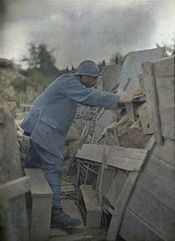
After entering Belgian territory, the German army soon encountered resistance at the fortified city of Liège. Although the army as a whole continued to make rapid progress into France, it was Britain's decision to honor a dated protection pact with Belgium and to declare war on Germany that left the German government in disbelief and seriously hindered their military plans. Britain sent an army to France (the British Expeditionary Force, or BEF) which advanced into Belgium and slowed the Germans. The first British soldier killed in the war was John Parr, on August 21, 1914, near Mons.
Initially, the Germans had great successes in the Battle of the Frontiers (August 14â24, 1914). However, Russia attacked in East Prussia and diverted German forces which were intended for the Western Front. Germany defeated Russia in a series of battles collectively known as the Second Battle of Tannenberg (August 17âSeptember 2). This diversion exacerbated problems of insufficient speed of advance from railheads not allowed for by the German General Staff. It also allowed French and British forces to finally halt the German advance on Paris at the First Battle of the Marne (September 1914) and the Entente forced the Central Powers to fight a war on two fronts. The German army had fought its way into a good defensive position inside France and had permanently incapacitated 230,000 more French and British troops than it had lost itself in the months of August and September. Yet staff incompetence and leadership timidity (such as Moltke the Younger needlessly transferring troops from the right to protect Sedan) cost Germany the chance for an early victory over France with its very ambitious war plan.
Early stages
Trench warfare begins
Trench warfare was the distinctive feature of the war. After the First Battle of the Marne, both Entente and German forces began a series of outflanking maneuvers to try to force the other to retreat, in the so-called Race to the Sea. The United Kingdom and France soon found themselves facing entrenched German positions from Lorraine to Belgium's Flemish coast. The United Kingdom and France sought to take the offensive, while Germany defended occupied territories. One consequence was that German trenches were much better constructed than those of their enemy: Anglo-French trenches were only intended to be temporary before their forces broke through German defenses. Some hoped to break the stalemate by utilizing science and technology. In April 1915 the Germans used chlorine gas for the first time, which opened a 4 mile wide hole in the Allied lines when French colonial troops retreated before it. This breach was closed by allied soldiers at the Second Battle of Ypres where over five thousand, mainly Canadian, soldiers were gassed to death and Third Battle of Ypres, where Canadian forces took the village of Passchendale with the help of the Allied Powers.
Neither side proved able to deliver a decisive blow for the next four years, though protracted German action at Verdun throughout 1916, and the Entente's failure at the Somme in the summer of 1916, brought the exhausted French army to the brink of collapse. Futile attempts at frontal assaultâwith a rigid adherence to unimaginative maneuversâcame at a high price for both the British and the French poilu (infantry) and led to widespread mutinies, especially during the time of the Nivelle Offensive in the spring of 1917. News of the Russian Revolution gave a new incentive to socialist sentiments among the troops, with its seemingly inherent promise of peace. Red flags were hoisted, and the Internationale was sung on several occasions. At the height of the mutiny, thirty thousand to forty thousand French soldiers participated.
Throughout 1915-1917 the British Empire and France suffered far more casualties than Germany. However, while the Germans only mounted a single main offensive at Verdun, each failed attempt by the Entente to break through German lines was met with an equally fierce German counteroffensive to recapture lost positions. Around eight hundred thousand soldiers from the British Empire were on the Western Front at any one time. One thousand battalions, each occupying a sector of the line from the North Sea to the Orne River, operated on a month long, four stage rotation system, unless an offensive was underway. The front contained over six thousand miles of trenches. Each battalion held its sector for about a week before moving back to support lines and then further back to the reserve lines before a week out-of-line, often in the Poperinge or Amiens areas.
In the British-led Battle of Arras during the 1917 campaign, the only military success was the capture of Vimy Ridge by the Canadian forces under Sir Arthur Currie and Julian Byng. It provided the British allies with great military advantage that had a lasting impact on the war and is considered by many historians as the founding myth of Canada.
Southern theaters
Ottoman Empire
The Ottoman Empire joined the Central Powers in October and November 1914 because of the secret Turko-German Alliance, which was signed in August 1914. It threatened Russia's Caucasian territories and Britain's communications with India and the East via the Suez Canal. The British Empire opened another front in the South with the Gallipoli and Mesopotamian campaigns in 1915. In Gallipoli, the Turks were successful in repelling the Australian and New Zealand Army Corps (ANZACs) and forced their eventual withdrawal and evacuation. In Mesopotamia, by contrast, after the disastrous Siege of Kut (1915â1916), British Empire forces reorganized and captured Baghdad in March 1917. Further to the west in the Sinai and Palestine Campaign, initial British failures were overcome when Jerusalem was captured in December 1917, and the Egyptian Expeditionary Force, under Field Marshall Edmund Allenby, broke the Ottoman forces at the Battle of Megiddo in September 1918.
Russian armies generally had the best of it in the Caucasus. Vice-Generalissimo Enver Pasha, supreme commander of the Turkish armed forces, was a very ambitious man with a dream to conquer central Asia, but he was not a practical soldier. After launching a frontal offensive with one hundred thousand troops against the Russians, called the Battle of Sarikamis, in the Caucasus in December of 1914, he lost 86 percent of his force.
General Nikolai Nikolaevich Yudenich, Russian commander from 1915 to 1916, achieved a string of victories over the Ottoman forces, driving them out of much of present day Armenia. Tragically, this would provide a context for the deportation and genocide against the Armenian population in eastern Armenia.
In 1917 Russian Grand Duke Nicholas (first cousin of Tsar Nicholas II) assumed senior control over the Caucasus front. Nicholas tried to have a railway built from Russian Georgia to the conquered territories with a view to bringing up more supplies for a new offensive in 1917. But, in March of 1917, the tsar was overthrown in the February Revolution and the Russian army began to slowly fall apart.
Italian participation
Italy had been allied with the German and Austro-Hungarian Empires since 1882. Italy had its own designs against Austrian territory in the Trentino, Istria, and Dalmatia, and maintained a secret 1902 understanding with France, which effectively nullified its previous alliance commitments. Italy refused to join Germany and Austria-Hungary at the beginning of the war because their alliance was defensive. The Austrian government started negotiations to obtain Italian neutrality in exchange for French territories namely Tunisia, but Italy joined the Triple Entente by signing the London Pact in April and declaring war on Austria-Hungary in May 1915; it declared war against Germany 15 months later.
In general, the Italians had numerical superiority but were poorly equipped. The Italians went on the offensive to relieve pressure on the other Allied fronts and achieve their territorial goals. In the Trentino-South Tyrol front, the Austro-Hungarian defense took advantage of the elevation of their bases in the mostly mountainous terrain, which was not suitable for military offensives. After an initial Austro-Hungaric strategic retreat to better positions, the front remained mostly unchanged, while Austrian KaiserschĂźtzen and StandschĂźtzen and Italian Alpini troops fought bitter, close combat battles during the summer and tried to survive during the winter in the high mountains. The Austro-Hungarians counterattacked in the Altopiano of Asiago towards Verona and Padua in the spring of 1916, known as the Strafexpedition, but they also made little progress.
Beginning in 1915, the Italians mounted 11 major offensives along the Isonzo River north of Trieste, known as the First through Eleventh Battles of the Isonzo. These attacks were repelled by the Austro-Hungarians who had the higher ground. In the summer of 1916, the Italians captured the town of Gorizia. After this minor victory, the front remained practically stable for over a year, despite several Italian offensives. In the fall of 1917, thanks to the improving situation on the Eastern front, the Austrians received large reinforcements, including German assault troops. The Central Powers launched a crushing offensive on October 26 that was spearheaded by German troops and supported by the Austrians and Hungarians. The attack resulted in the victory of Caporetto; the Italian army was routed, but after retreating more than 60 miles, it was able to reorganize and hold at the Piave River. In 1918 the Austrians repeatedly failed to break the Italian line and, decisively defeated in the Battle of Vittorio Veneto, surrendered to the Entente powers in November.
War in the Balkans
Faced with the Russian threat, Austria-Hungary could spare only one-third of its army for Serbia. After suffering tremendous losses, the Austrians briefly captured the Serbian capital, but Serb counterattacks succeeded in expelling the invaders from the country by the end of 1914. For the first ten months of 1915. Austria used most of its spare armies to fight Italy. However, German and Austrian diplomats scored a great coup by convincing Bulgaria to join in a new attack on Serbia.
The conquest of Serbia was finally accomplished in a little more than a month, starting on October 7, when the Austrians and Germans attacked from the north. Four days later the Bulgarians attacked from the east. The Serbian army, attacked from two directions and facing certain defeat, retreated east and south into Albania, and then by ship to Greece. In late 1915, a Franco-British force landed at Salonica in Greece to offer assistance and to pressure the Greek government into war against the Central Powers. Unfortunately for the Allies, the pro-Allied Greek government of Eleftherios Venizelos was dismissed by the pro-German King Constantine I before the Allied expeditionary force had even arrived.
The Salonica Front proved entirely immobile, so much so that it was joked that Salonica was the largest German prisoner of war camp. Only at the very end of the war were the Entente powers able to make a breakthrough, which was after most of the German and Austro-Hungarian troops had been removed, leaving the Front held by the Bulgarians alone. This led to Bulgaria's signing an armistice on September 29, 1918.
Eastern Front
Initial actions
While the Western Front had reached stalemate in the trenches, the war continued in the east. The Russian initial plans for war had called for simultaneous invasions of Austrian Galicia and German East Prussia. Although Russia's initial advance into Galicia was largely successful, they were driven back from East Prussia by the victories of the German generals Hindenburg and Ludendorff at the battles of Tannenberg and Masurian Lakes in August and September 1914. Russia's less-developed industrial base and ineffective military leadership was instrumental in the events that unfolded. By the spring of 1915, the Russians were driven back in Galicia and in May, the Central Powers achieved a remarkable breakthrough on Poland's southern fringes, capturing Warsaw on August 5 and forcing the Russians to withdraw from all of Poland. This became known as the "Great Retreat" by the Russian Empire and the "Great Advance" by Germany.
Russian Revolution
Dissatisfaction with the Russian government's conduct of the war grew despite the success of the June 1916 Brusilov offensive in eastern Galicia against the Austrians. The Russian success was undermined by the reluctance of other generals to commit their forces in support of the victorious sector commander. Allied and Russian forces revived only temporarily with Romania's entry into the war on August 27; German forces came to the aid of embattled Austrian units in Transylvania, and Bucharest fell to the Central Powers on December 6. Meanwhile, internal unrest grew in Russia as the tsar remained out of touch at the front. Empress Alexandra's increasingly incompetent rule drew protests from all segments of Russian political life and resulted in the murder of Alexandra's favorite, Grigori Rasputin, by conservative noblemen at the end of 1916.
In March 1917 demonstrations in St. Petersburg culminated in the abdication of Tsar Nicholas II and the appointment of a weak Russian Provisional Government, which shared power with the socialists of the Petrograd Soviet. This division of power led to confusion and chaos both on the front and at home, and the army became increasingly ineffective.
The war, and the government, became more and more unpopular, and the discontent led to a rise in popularity of the Bolshevik political party, led by Vladimir Lenin, who were able to gain power. The October Revolution was followed in December by an armistice and negotiations with Germany. At first, the Bolsheviks refused to agree to the harsh German terms, but when Germany resumed the war and marched with impunity across Ukraine, the new government acceded to the Treaty of Brest-Litovsk on March 3, 1918, which took Russia out of the war and ceded vast territories, including Finland, the Baltic provinces, Poland, and Ukraine to the Central Powers.
After the Russians dropped out of the war, the Entente no longer existed. The Allied Powers led a small-scale invasion of Russia. The invasion was made with intent primarily to stop Germany from exploiting Russian resources and, to a lesser extent, to support the Whites in the Russian Revolution. Troops landed in Archangel and in Vladivostok.
1917â1918
The events of 1917 were decisive in ending the war, although their effects would not be fully felt until 1918. The British naval blockade of Germany began to have a serious impact on morale and productivity on the German home front. In response, in February 1917, the German General Staff was able to convince Chancellor Theobald von Bethmann-Hollweg to declare unrestricted submarine warfare, with the goal of starving the United Kingdom out of the war. Tonnage sunk rose above five hundred thousand tons per month from February until July, peaking at 860,000 tons in April. After July, the reintroduced convoy system was extremely effective in neutralizing the U-boat threat, thanks to American experimentation. Britain was safe from the threat of starvation, and the German war industry remained deprived materially.
The decisive victory of Germany at the Battle of Caporetto led to the Allied decision at the Rapallo Conference to form the Supreme Allied Council at Versailles to coordinate plans and action. Previously, British and French armies had operated under separate command systems.
In December, the Central Powers signed an armistice with Russia, which released troops from the eastern front for use in the west. Ironically, German troop transfers could have been greater if their territorial acquisitions had not been so dramatic. With both German reinforcements and new American troops pouring into the Western Front, the final outcome of the war was to be decided in that front. The Central Powers knew that they could not win a protracted war now that American forces were certain to be arriving in increasing numbers, but they held high hopes for a rapid offensive in the West using their reinforced troops and new infantry tactics. Furthermore, the rulers of both the Central Powers and the Allies became more fearful of the threat first raised by Ivan Bloch (1836â1929), the Polish financier and war theoretician in 1899, that protracted industrialized war threatened social collapse and revolution throughout Europe. Both sides urgently sought a decisive, rapid victory on the Western Front because they were both fearful of collapse or stalemate.
Entry of the United States
America's policy of insisting on neutral rights while also trying to broker a peace resulted in tensions with both Berlin and London. U.S. President Woodrow Wilson repeatedly warned that he would not tolerate unrestricted submarine warfare, and the Germans repeatedly promised to stop. A proposal to Mexico to join the war against the Allies was exposed in February, bringing war closer. After further U-boat (German submarines) attacks on American merchant ships, Wilson requested that Congress declare war on Germany, which it did on April 6, 1917. The U.S. House of Representatives approved the war resolution 373-50, the U.S. Senate 82-6, with opposition coming mostly from German American districts. Wilson hoped war could be avoided with Austria-Hungary; however, when it kept its loyalty to Germany, the U.S. declared war on Austria-Hungary in December 1917.
Although the American contribution to the war was important, particularly in terms of the threat posed by an increasing U.S. infantry presence in Europe, the United States was never formally a member of the Allies, but an "Associated Power." Significant numbers of fresh American troops arrived in Europe in the summer of 1918, and they started arriving at ten thousand per day.
Germany miscalculated that it would be many more months before large numbers of American troops could be sent to Europe, and that, in any event, the U-boat offensive would prevent their arrival.
The United States Navy sent a battleship group to Scapa Flow to join with the British Grand Fleet, several destroyers to Queenstown, Ireland and several submarines to the Azores and to Bantry Bay, Ireland to help guard convoys. Several regiments of U.S. Marines were also dispatched to France. However, it would be some time before the United States would be able to contribute significant manpower to the Western and Italian Fronts.
The British and French wanted the United States to send its infantry to reinforce their troops already on the battle lines, and not use scarce shipping to bring over supplies. Consequently, Americans primarily used British and French artillery, airplanes, and tanks. However, General John J. Pershing, American Expeditionary Force (AEF) commander, refused to break up American units to be used as reinforcements for British Empire and French units (though he did allow African American combat units to be used by the French). Pershing ordered the use of frontal assaults, which had been discarded by that time by British Empire and French commanders as too costly in lives of their troops. To the astonishment of the Allies, the dispirited Germans broke and ran when the Americans came running, and the AEF suffered the lowest casualty rate of any army on the Western Front, with most recorded deaths being attributed to disease.
German Spring Offensive of 1918
German General Erich Ludendorff drew up plans (codenamed Operation Michael) for a 1918 general offensive along the Western Front, aiming to divide the British and French armies in a series of feints and advances by striking a decisive blow against the enemy before significant United States forces could be deployed. Before the offensive even began, Ludendorff made what was possibly a fatal mistake; he left the elite Eighth Army in Russia, sending over a few German troops from the east to aid the offensive in the west.
Operation Michael opened on March 21, 1918, with an attack against British Empire forces near the rail junction at Amiens. Ludendorff's plan was to split the British Empire and French armies at this point. German forces achieved an unprecedented advance of 40 miles. For the first time since 1914, maneuvering was achieved on the battlefield.
British and French trenches were defeated using novel infiltration tactics. Instead of the usual long artillery bombardments and continuous front mass assaults, the German Army started to use artillery briefly to infiltrate the line with small groups of infantry at weak points, attacking command and logistics areas and surrounding points of serious resistance. More heavily armed infantry then destroyed these isolated positions. German success relied greatly on this tactic.
The front line had now moved to within 75 miles of Paris. Three super-heavy Krupp railway guns advanced and fired 183 shells on Paris, which caused many Parisians to flee the city. The initial stages of the offensive were so successful that German Kaiser Wilhelm II declared March 24 a national holiday. Many Germans thought victory was close; however, after heavy fighting, the German offensive was halted. The Germans had brilliant new storm trooper, or Hutier tactics that avoided the trenches and sent small units on preplanned raids deep behind the lines to control and communication centers. That worked very well, but the Germans, lacking tanks or motorized artillery, were unable to consolidate their positions. The British and French learned that they had to fall back a few miles and the Germans would be disorganized and vulnerable to counterattack.
American divisions, which Pershing had sought to field as an independent force, were assigned to the depleted French and British Empire commands on March 28. A supreme command of Allied forces was created at the Doullens Conference, in which British Field Marshal Douglas Haig handed control of his forces over to French Marshall Ferdinand Foch.
Following Operation Michael, Germany launched Operation Georgette to the north against the English Channel ports. This was halted by the Allies with less significant territorial gains to Germany. Operations BlĂźcher and Yorck were then conducted by the German Army to the south, broadly towards Paris. Next, Operation Marne was launched on July 15 in an attempt to encircle Reims, beginning the Second Battle of the Marne. The resulting Allied counterattack marked their first successful offensive of the war. By July 20, the Germans were back at their Kaiserschlacht starting lines, having achieved nothing. Following this last phase of the ground war in the West, the German Army never again held the initiative. German casualties between March and April 1918 were 270,000, including many of the highly trained storm troopers. Their best soldiers were gone just as the Americans started arriving.
Meanwhile, Germany was crumbling internally as well. Anti-war marches were a frequent occurrence and morale within the army was at low levels. Industrial output had fallen 53 percent since 1913.
Allied victory: summer and autumn 1918
The Allied counteroffensive, known as the Hundred Daysâ Offensive began on August 8, 1918. The Battle of Amiens developed with III Corps Fourth British Army on the left, the First French Army on the right, and the Canadian and Australian Corps spearheading the offensive in the center. It involved 414 tanks of the Mark IV and Mark V type, and 120,000 men. They advanced as far as seven miles into German-held territory in just seven hours. Erich Ludendorff (1865â1937), a leading German General, referred to this day as "the Black Day of the German army." Ludendorff wrote extensively on the conduct of the war, which he believed had been defensive.
After a few days, the offensive had slowed downâBritish Empire units had encountered problems with all but seven tanks. On August 15, General Haig called a halt and began planning a new offensive in Albert, Somme. This Second Battle of the Somme began on August 21. Some 130,000 United States troops were involved, along with soldiers from Third and Fourth British Armies. It was an overwhelming success for the Allies. The German Second Army was pushed back over a 34 mile front. The town of Bapaume was captured on August 29 and by September 2 the Germans were on the Hindenburg Line, which was the starting point of the war.
The Allied attempt to take the Hindenburg Line (the Meuse-Argonne Offensive) began on September 26, as 260,000 American soldiers went "over the top." All divisions were successful in capturing their initial objectives, except the U.S. Seventy-Ninth Infantry Division, which met stiff resistance at Montfaucon and took an extra day to capture the objective.
By the start of October, it was evident that Germany could no longer mount a successful defense, let alone a counterattack. On the frontline they were increasingly outnumbered, with the few new recruits too young or too old to be of much help. Rations were cut for men and horses because the food supply was critical. Ludendorff had decided by October 1 that Germany had two ways out of the Warâtotal annihilation or an armistice. He recommended the latter to senior German officials at a summit on that very same day. During October, Pershing's artillery continued to unrelentingly pound the exhausted and bewildered Germans, all along the Meuse-Argonne front. The Allied pressure did not let up until the end of the war.
Meanwhile, news of Germany's impending military defeat had spread throughout the German Armed forces. The threat of general mutiny was rife. Naval commander Admiral Reinhard Scheer and Ludendorff decided to launch a last ditch attempt to restore the "valor" of the German Navy. Knowing any such action would be vetoed by the government of Prince Maximilian of Baden, Ludendorff decided not to inform him. Nonetheless, word of the impending assault reached sailors at Kiel. Many rebelled and were arrested, refusing to be part of a naval offensive which they believed to be nothing more than a suicide bid. It was Ludendorff who took the blame for thisâthe Kaiser dismissed him on October 26.
With power coming into the hands of new men in Berlin, further fighting became impossible. With 6 million German casualties, Germany moved toward peace. Prince Maximilian of Baden took charge of the new German government. Negotiations for peace began immediately upon his appointment. In the matter of the German monarchy, he was torn between the ideas of a constitutional monarchyâin which he himself was in line for the crownâor a republic. President Wilson demanded the abdication of the Kaiser and there was no resistance when the Social Democratic Philipp Scheidemann declared Germany to be a republic on November 9. Von Baden then announced that the Kaiser was to abdicate, along with all other princes in the Reich. Imperial Germany was dead; a new Germany had been bornâthe Weimar Republic.
End of war
The collapse of the Central Powers came swiftly. Bulgaria was the first to sign an armistice (September 29, 1918). Faced with the opening of a second front in the Austrian rear, Ludendorff and Hindenberg demanded that the government pursue a negotiated peace. On October 3 Germany and Austria-Hungary appealed to President Wilson for an immediate armistice. The sailors of Germany's High Seas Fleet mutinied starting October 29, and rebellion quickly spread throughout western Germany. On October 30 the Ottoman Empire capitulated. On November 4 the Armistice with Austria was granted to take effect at 3:00 in the afternoon. Austria and Hungary signed separate armistices following the overthrow of the Habsburg monarchy and the collapse of the Austro-Hungarian Empire.
Following the outbreak of the German Revolution, a republic was proclaimed on November 9, marking the end of the monarchy. The Kaiser fled the next day to the neutral Netherlands, which granted him political asylum.
On November 11 an armistice with Germany was signed in a railroad carriage at Compiègne in France where Germans had previously dictated terms to France, ending the Franco-Prussian War in 1871.
At 11:00 a.m. on November 11, 1918, a ceasefire came into effect and the opposing armies on the Western Front began to withdraw from their positions. Canadian George Lawrence Price is traditionally regarded as the last soldier killed in the Great War: he was shot by a German sniper and died at 10:58 a.m.
A formal state of war between the two sides persisted for another seven months until it was finally ended by the signing of the Treaty of Versailles on June 28, 1919, with Germany, and the following treaties with Austria, Hungary, Bulgaria, and The Ottoman Empire signed at St. Germain, Trianon, Neuilly, and Sèvres respectively. However, the latter treaty with the Ottoman Empire was followed by strife (the Turkish Independence War) and a final peace treaty was signed between the Allied Powers and the country that would shortly become the Republic of Turkey, at Lausanne on July 24, 1923.
Some war memorials date the end of the war as being when the Versailles treaty was signed in 1919; by contrast, most commemorations of the war's end concentrate on the armistice of November 11, 1918. Legally the last formal peace treaties were not signed until 1923.
Economics and manpower issues
All nations saw increases in government share of gross domestic product (GDP), surpassing 50 percent in both Germany and France and nearly reaching 50 percent in Britain. To pay for purchases in the U.S., Britain cashed in its massive investments in American railroads and then borrowed heavily on Wall Street. President Wilson was on the verge of cutting off the loans in late 1916, but with war imminent with Germany, he allowed a massive increase in U.S. government lending to the Allies. After 1919, the U.S. demanded repayment of these loans, which, in part, were funded by German reparations, which, in turn, were supported by American loans to Germany. This circular system collapsed in 1931 and the loans were never repaid.
One of the most dramatic effects of the end of the war was the expansion of governmental powers and responsibilities in the United Kingdom, France, the United States, and the Dominions of the British Empire. To harness all the power of their societies, new government ministries and powers were created. New taxes were levied and laws enacted, all designed to bolster the war effort. Many of these continue to this day.
The war strained the abilities of formerly large and bureaucratized governments such as those in Austria-Hungary and Germany. Here, however, the long term effects were clouded by the defeat of these governments.
Families were altered by the departure of many men. With the death or absence of the primary wage earner, women were forced into the workforce in unprecedented numbers. At the same time, industry needed to replace the lost laborers sent to war. This aided the struggle for voting rights for women.
As the war slowly turned into a war of attrition, conscription was implemented in some countries. This issue was particularly explosive in Canada and opened a political gap between the French-Canadiansâwho claimed their true loyalty was to Canada and not the British Empireâand the English-speaking majority who saw the war as a duty to both Britain and Canada, and a way of demonstrating leadership and high-contribution to the British Empire. Prime Minister Sir Robert Borden pushed through a Military Service Act that caused the Conscription Crisis of 1917.
In Britain, rationing was finally imposed in early 1918 and was limited to meat, sugar, and fats (butter and oleo), but not bread. The new system worked smoothly. From 1914 to 1918 trade union membership doubled, from a little over 4 million to a little over 8 million. Work stoppages and strikes became frequent in 1917â1918 as the unions expressed grievances regarding prices, liquor control, pay disputes, "dilution," fatigue from overtime and from Sunday work, and inadequate housing. Conscription put nearly every physically fit man into uniform, 6 million out of the 10 million eligible in Britain. About 750,000 lost their lives and 1,700,000 were wounded. Most fatalities were young unmarried men; however, 160,000 wives lost husbands and three hundred thousand children lost fathers.
Technology
The First World War has been described as clash of twentieth century technology with nineteenth century tactics. Millions of soldiers, both volunteers and conscripts, fought on all sides, with Kitchener's Army being a notable all volunteer force.
Much of the war's combat involved trench warfare, where hundreds often died for each yard of land gained. Many of the deadliest battles in history occurred during the First World War, including the Battles of Ypres, Vimy Ridge, Marne, Cambrai, Sommm, and Verdun and artillery was responsible for the largest number of casualties during the First World War. Vast quantities of explosives were used. Despite having been outlawed by the Hague Conventions (1899 and 1907), chemical weapons such as mustard gas, phosgene and tear gas, and aerial bombardment were used. Casualties from chemical weapons were few but the psychological impact was devastating. Countermeasures such as gas-masks became more effective as the war progressed.
Perhaps the most powerful weapons of the Great War were railway-mounted heavy guns, which became increasingly larger. As each belligerent nation increased the firepower and range of its artillery, the other nations were required to respond likewise in order to prevent the technological superiority of any given military power. The naval guns of the day were the largest guns on the planet, and weighed hundreds of tons apiece. Thus, a method for transporting these guns was essential, and railroads became the favored means. The largest U.S., British, and French rail guns were severely outranged by the German Krupp, Max E, and Paris Guns.
Fixed-wing aircrafts were first used militarily during the First World War. Initial uses consisted primarily of reconnaissance, though this developed into ground attack and fighter duties as well. Strategic bombing aircrafts were created principally by the Germans and British, though the former used Zeppelins (dirigible balloons) to this end as well.
U-boats (submarines) were used in combat shortly after the war began. Alternating between restricted and unrestricted submarine warfare during the First Battle of the Atlantic, they were employed by the Kaiserliche Marine in a strategy of defeating the British Empire through a tonnage war. The deaths of British merchantmen and the invulnerability of U-boats led to the development of several countermeasures: depth charges (1916), hydrophones (passive sonar, 1917), blimps, hunter-killer submarines (HMS R-1, 1917), ahead-throwing weapons, and dipping hydrophones (abandoned in 1918). To extend their operations, the Germans proposed supply submarines (1916). Most of these would be forgotten in the interwar period until World War II revived the need.
Tanks were introduced in World War I by the British and created mechanized warfare that dominated the rest of the twentieth century. The first tank was nicknamed Mother. The first use of tanks was during the Battle of the Somme on September 15, 1916. This was not as successful as intended, but as a start the tanks proved their value against the machine gun. Trenches, the machine gun, air reconnaissance, barbed wire, and modern artillery with shrapnel helped stalemate the battle lines of World War I by making massed infantry attacks deadly for the attacker. The infantry was armed mostly with a bolt action magazine rifle, but the machine gun, with the ability to fire hundreds of rounds per minute, blunted infantry attacks as an offensive weapon; therefore, the British sought a solution and created the tank. Their first use proved tanks needed infantry support and massed formations, but within a year the British were fielding tanks by the hundreds and showed their potential during the Battle of Cambrai in November 1917 by breaking the Hindenburg Line while capturing eight thousand enemy and one hundred artillery guns.
Captive balloons were used as stationary reconnaissance points on the front lines. Balloons commonly had a crew of two with parachutes; upon an enemy air attack on the flammable balloon the balloon crew would parachute. Recognized for their value as observer platforms, they were important targets of enemy aircrafts; fixed, they were also heavily defended by antiaircraft guns. Blimps and balloons helped contribute to the stalemate of the trench warfare of World War I, and the balloons contributed to air to air combat among the aircrafts to defend the skies for air superiority because of their significant reconnaissance value. The Germans conducted air raids during 1915 and 1916 on England with the intent to damage the morale and will to fight of the British and to cause aircrafts to be reassigned to England away from the front lines.
Aftermath
The First World War ended with Europe scarred by trenches, spent of its resources, and littered with the bodies of the millions who died in battle. The direct consequences of World War I brought many old regimes crashing to the ground, and ultimately, would lead to the end of three hundred years of European hegemony in the world.
No other war had changed the map of Europe so dramaticallyâfour empires were shatteredâthe German, the Austro-Hungarian, the Ottoman, and the Russian. Their four dynasties, the Hohenzollerns, the Habsburgs, the Ottomans, and the Romanovs, who had roots of power back to the days of the Crusades, all fell during or after the war. After the war, Germany's overseas colonies were placed under Allied control and provinces of the former Ottoman Empire were mandated to France, Italy, and the United Kingdom. The size of Germany was also reduced. Heavy reparations were written into the treaty, together with restrictions on the manufacture of arms.
In Australian and New Zealand popular legend, the First World War is known as the nation's "baptism of fire," as it was the first major war in which the newly established countries fought, and it is one of the first cases where Australian troops fought as Australians, not just subjects of the British Crown. Anzac Day (Australia New Zealand Army Corps) is thus held in great reverence by many Australians and New Zealanders.
Similarly, Anglo-Canadians believe that they proved they were their own country and not just subjects of the British Empire. Indeed, many Canadians refer to their country as a nation "forged from fire," as Canadians were respected internationally as an independent nation from the conflagrations of war and bravery. Like their British counterparts, Canadians commemorate the war dead on Remembrance Day. Indian troops had also fought in the war and now felt that they should have a greater say in running India.
Social trauma
The experiences of the war led to a collective national trauma afterwards for all the participating countries. The optimism for world peace of the 1900s was entirely gone, and those who fought in the war became what is known as "the Lost Generation" because they never fully recovered from their experiences. For the next few years, much of Europe began its mourning; memorials were erected in thousands of villages and towns.
This social trauma manifested itself in many different ways. Some people were revolted by nationalism and what it had supposedly caused and began to work toward a more internationalist world, supporting organizations such as the League of Nations. Pacifism became increasingly popular. Others had the opposite reaction, feeling that only strength and military might could be relied upon for protection in a chaotic and inhumane world that did not respect hypothetical notions of civilization. "Anti-modernist" views were a reaction against the many changes taking place within society.
The rise of Nazism and fascism included a revival of the nationalistic spirit of the pre-war years and, on principle, a rejection of many post-war changes. Similarly, the popularity of the Dolchstosslegende (the theory that German defeat was due to internal treason and lack of national unity) was a testament to the psychological state of the defeated, as acceptance of the scapegoat mythos signified a rejection of the "lessons" of the war and therefore, a rejection of its popular resulting perspective. Also, the extreme economic hardship in Germany that developed after the war helped breed conditions for Hitler's rise to power there.
Certainly a sense of disillusionment and cynicism became pronounced, with Nihilism growing in popularity. This disillusionment towards humanity found a cultural climax with the pessimistic existentialism of Sartre and Camus and Dadaist artistic movement. Many people believed that the war heralded the end of the world as they had known it, including the collapse of capitalism and imperialism. Communist and socialist movements around the world drew strength from this theory and enjoyed a level of popularity they had never known before. These feelings were most pronounced in areas directly or particularly harshly affected by the war, especially within Europe.
Notes
- â Hobson, John A., Imperialism. Retrieved June 11, 2007.
- â Lenin, Vladimir, Imperialism: The Highest Stage of Capitalism. Retrieved June 11, 2007.
- â MIT, Imperial Russian Council St. Petersburg, July 1914 Supplemental Guide. Retrieved June 11, 2007.
- â World War One Color Photos Retrieved June 11, 2007.
ReferencesISBN links support NWE through referral fees
- Beaver, Daniel R. Newton D. Baker and the American War Effort, 1917-1919. Lincoln: University of Nebraska. 1966.
- Beesly, Patrick. Room 40. Oxford, New York: Oxford University. 1984. ISBN 0192814680
- Bidwell, Shelford, and Graham, Dominick. Firepower: British Army Weapons and Theories of War, 1904-1945. Boston: Allen & Unwin. 1985. ISBN 0049421905
- Broadberry, Stephen and Harrison, Mark. eds. The Economics of World War I. Cambridge and NY: Cambridge University. 2005. ISBN 0521852129
- Buchan, John. A History of the Great War. 4 Vols. Annapolis, MD: Nautical and Aviation Pub. Co. of America. 1980. ISBN 093385210X
- Carver, Michael. The War Lords : Military Commanders of the Twentieth Century. Barnsley, South Yorkshire: Pen & Sword Military Classics. 2005. ISBN 1844153088
- Cassar, George H. Kitchener's War: British Strategy from 1914 to 1916. Washington, DC: Brasseyâs. 2004. ISBN 1574887084
- Chambers II, John W. To Raise an Army: The Draft Comes to Modern America. New York: Free; London: Collier Macmillan. 1987. ISBN 0029058201
- Coffman, Edward M. The War to End All Wars: The American Military Experience in World War I. Lexington, KY: University Press of Kentucky. 1998. ISBN 0813109558
- Cruttwell, C. R. M. F. A History of the Great War, 1914-1918. Chicago, IL: Academy Chicago. 1991. ISBN 0897333152
- Editors of American Heritage. History of WWI. Simon & Schuster. 1964.
- Evans, R. J. W., and Von Strandman, Hartmut Pogge. eds. The Coming of the First World War. Oxford: Clarendon; New York: Oxford University. 1988. ISBN 0198228996
- Falls, Cyril. The Great War. Norwalk, CT: Easton. 1987.
- Ferguson, Niall. The Pity of War. New York: Basic Books. 1999. ISBN 0465057128
- Gilpin, Robert. War and Change in World Politics. Cambridge, New York: Cambridge University. 1981. ISBN 0521240182
- Gudmundsson, Bruce I. Stormtroop Tactics: Innovation in the German Army, 1914-1918. New York: Praeger. 1989. ISBN 0275933288
- Hallas, James H. Doughboy War: The American Expeditionary Force in World War I. Boulder, Col: Lynne Rienner Publishers. 2000. ISBN 1555878555
- Hamilton, Richard F. and Herwig, Holger H. Decisions for War, 1914-1917. Cambridge, New York: Cambridge University. 2004. ISBN 0521545307
- Hardach, Gerd. The First World War 1914-1918. Berkeley: University of California. 1977. ISBN 0520030605
- Henig, Ruth. The Origins of the First World War. London; New York: Routledge. 2002. ISBN 0415261856
- Herwig, Holger H. The First World War: Germany and Austria-Hungary 1914-1918. London, New York: Arnold. 1997. ISBN 0340573481
- Higham, Robin and Showalter, Dennis E. eds. Researching World War I: A Handbook. Westport, CT: Greenwood. 2003. ISBN 031328850X
- Holley, I. B. Ideas and Weapons: Exploitation of the Aerial Weapon by the United States During World War I. Washington, DC: Office of Air Force History: For sale by the Supt. of Docs. U.S. GPO. 1983. ISBN 0912799110
- Hoover, Herbert. Ordeal of Woodrow Wilson. p 47. 1918.
- Howard, Michael. The First World War Oxford, New York: Oxford University. 2002. ISBN 0192853627
- Howarth, Stephen. To Shining Sea: A History of the United States Navy, 1775-1991. New York: Random House. 1991. ISBN 0394576624
- Hubatsch, Walther. Germany and the Central Powers in the World War, 1914- 1918. Lawrence: University of Kansas. 1963.
- Hurley, Alfred F. Billy Mitchell, Crusader for Air Power. Bloomington: Indiana University. 1975. ISBN 0253312035
- Joll, James. The Origins of the First World War. London; New York: Longman. 1992. ISBN 0582089204
- Kahn, David. The Codebreakers. New York: Scribner. 1996. ISBN 0684831309
- Kahn, David. The Reader of Gentlemen's Mail: Herbert O. Yardley and the Birth of American Codebreaking. New Haven: Yale University. 2004. ISBN 0300098464
- Keegan, John. The First World War. New York: A. Knopf. 1999. ISBN 0375400524
- Kennedy, David M. Over Here: The First World War and American Society. Oxford, UK; New York: Oxford University. 2004. ISBN 0195173996
- Kennedy, Paul M. The Rise of the Anglo-German Antagonism, 1860-1914. London: Atlantic Highlands; NJ: Ashfield. 1987. ISBN 0948660066
- Kennedy, Paul M. ed. The War Plans of the Great Powers, 1880-1914. Boston: Allen & Unwin. 1985. ISBN 0049400827
- Knutsen, Torbjørn L. The Rise and Fall of World Orders. Manchester, UK: Manchester University; New York: Martinâs.1999. ISBN 0719040582
- Koistinen, Paul. Mobilizing for Modern War: The Political Economy of American Warfare, 1865-1919. Lawrence, Kan: University Press of Kansas. 1997. ISBN 0700608605
- Lee, Dwight E. ed. The Outbreak of the First World War: Who Was Responsible? Boston: Heath. 1963.
- Liddell Hart, B. H. The Real War 1914-1918. Boston: Little; Brown. 1963; 1930.
- Lincoln, W. Bruce. Passage Through Armageddon: The Russians in War and Revolution, 1914-1918. New York: Simon and Schuster. 1986. ISBN 0671557092
- Lyons, Michael J. World War I: A Short History. (2nd Edition). Upper Saddle River, N.J: Prentice Hall. 2000. ISBN 0130205516
- Messenger, Charles. Call To Arms: The British Army 1914-1918. London: Weidenfeld & Nicolson. 2005. ISBN 0297846957
- Milner, Prof. Marc. Canadian Military History. Toronto: Irwin. 1998. ISBN 0772525137
- Morrow Jr., John H. The Great War: An Imperial History. London; New York: Routledge. 2004. ISBN 0415204399
- Morton, Desmond, and Granatstein, J. L. Marching to Armageddon: Canadians and the Great War 1914-1919. Toronto, Canada: Lester & Orpen Dennys. 1989. ISBN 0886192110
- Phillips, Kevin. American Theocracy. NY: Viking. 2005. ISBN 9780670034864
- Ponting, Clive. Thirteen Days: The Road to the First World War. London: Chatto & Windus. 2002. ISBN 0701172932
- Pope, Stephen and Wheal, Elizabeth-Anne. eds. The Macmillan Dictionary of the First World War. Yorkshire: Pen & Sword Military Classics. 2003. ISBN 0850529794
- Robbins, Keith. The First World War. Oxford, New York: Oxford University. 1993. ISBN 0192891499
- Russell, Bertrand. Why I am Not a Christian. NY: Viking. 1957. ISBN 0671203231
- Sheffield, G. D. Leadership in the Trenches: Officer-Man Relations, Morale and Discipline in the British Army in the Era of the First World War. New York: St. Martinâs. 2000. ISBN 0312226403
- Shotwell, James T. Economic and Social History of the World War. Washington: Carnegie Endowment for International Peace. 1924.
- Slosson, Preston William. The Great Crusade and after, 1914-1928. New York: Macmillan. 1930.
- Smith, Leonard V. Between Mutiny and Obedience. The Case of the French Fifth Infantry Division during World War I. Princeton, NJ: Princeton University. 1994. ISBN 0691033048
- Stevenson, David. Cataclysm: The First World War as Political Tragedy. New York: Basic Books. 2004. ISBN 0465081843
- Stevenson, David. The First World War and International Politics. Oxford, New York: Oxford University. 1988. ISBN 0198730497
- Stokesbury, James. A Short History of World War I. New York: Morrow. 1981. ISBN 0688001297
- Strachan, Hew. The First World War: Volume I: To Arms. New York: Viking. 2004. ISBN 0670032956
- Stubbs, Kevin D. Race to the Front: The Material Foundations of Coalition Strategy in the Great War. Westport, Conn: Praeger. 2002. ISBN 0275972992
- Taylor, A. J. P. The First World War: An Illustrated History. London: Hamish Hamilton. 1963.
- Time Magazine. Warm Water Friendship. Retrieved June 12, 2007.
- Toland, John. No Man's Land. 1918âThe Last Year of the Great War. Lincoln: University of Nebraska. 2002. ISBN 0803294514
- Trask, David F. The United States in the Supreme War Council: American War Aims and Inter-Allied Strategy, 1917-1918. Westport, CT: Greenwood. 1978. ISBN 0313200068
- Trumbo, Dalton. Johnny Got His Gun. New York: L. Stuart. 1970.
- Tuchman, Barbara. The Guns of August. New York: Ballantine. 1994. ISBN 034538623X
- Tuchman, Barbara W. The Zimmermann Telegram. New York: Macmillan. 1966.
- Tucker, Spencer. ed. The Encyclopedia of World War I: A Political, Social, and Military History. Vol. 5. Santa Barbara, CA: ABC-CLIO. 2005. ISBN 1851094202
- Tucker, Spencer. ed. European Powers in the First World War: An Encyclopedia. New York: Garland. 1996. ISBN 081533351X
- Turner, John. ed. Britain and the First World War. London and Boston: Unwin Hyman. 1988. ISBN 0044451091
- University of Calgary Social Science. Centre for Military and Strategic Studies. Retrieved June 12, 2007.
- Venzon, Anne. ed. The United States in the First World War: An Encyclopedia. New York: Garland. 1995. ISBN 0824070550
- Wade, Mason. The French Canadians, 1760-1945. London: Macmillan. 1955.
- A Web of English History. Russia 1870-1917. Retrieved June 12, 2007.
- Winter, J. M. Capital Cities at War: Paris, London, Berlin, 1914-1919. Cambridge, UK; New York: Cambridge University. 1997. ISBN 0521571715
- Winter, J. M. The Experience of World War I. New York: Oxford University. 1989. ISBN 0195207769
- Wynn, Neil A. From Progressivism to Prosperity: World War I and American Society. New York: Holmes & Meier. 1986. ISBN 084191107X
External links
All links retrieved May 20, 2023.
- The Library of Congress. World War I Resources.
- BBC. The War to End All Wars.
- The Heritage of the Great War. The Heritage of the Great War / First World War 1914â1918.
- GenealogyBuff.com. World War I Casualties of American Army Overseasâ1918.
- The Long, Long Trail. The British Army in the Great War.
- Historique de Regiments.
- Swaim, Don. Fighting the Hun in the Great War.
- World War I. Trenches on the Web.
- Military Indexes. Online World War I Indexes & Records.
- Brigham Young University. World War I Document Archive.
- Brigham Young University. The Medical Front WWI
- World War I Naval Combat. World War I Naval Combat
- Internet Archive. Memoirs of the Great War.
- Military History Index. The Great War 1914â1918.
Credits
New World Encyclopedia writers and editors rewrote and completed the Wikipedia article in accordance with New World Encyclopedia standards. This article abides by terms of the Creative Commons CC-by-sa 3.0 License (CC-by-sa), which may be used and disseminated with proper attribution. Credit is due under the terms of this license that can reference both the New World Encyclopedia contributors and the selfless volunteer contributors of the Wikimedia Foundation. To cite this article click here for a list of acceptable citing formats.The history of earlier contributions by wikipedians is accessible to researchers here:
The history of this article since it was imported to New World Encyclopedia:
Note: Some restrictions may apply to use of individual images which are separately licensed.
